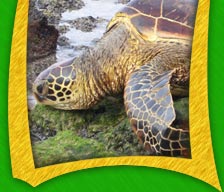



 |
||
|
THREATS Each year, thousands of newly hatched turtles making their way to the sea fall prey to birds, crabs, raccoons and other natural predators; however, humans pose the greatest threat. For example, it is not uncommon for sea turtle by-catch, or non-deliberate catch, to drown in commercial fishing equipment such as shrimp trawls and gill nets. Sea turtles are air-breathing reptiles that must surface in order to survive. Simple items, such as plastic bags or balloons can also be hazardous. Confusing marine debris for food can be deadly for Leatherback sea turtles whose diet consists of jellyfish. An even more direct threat is the black market trade for turtle eggs and meat. For centuries, a variety of cultures have hunted sea turtles for consumption.
As urban development encroaches on our shores, coastal armoring creates restricted access to essential nesting grounds. Massive beach structures such as sea walls and sandbags prevent female turtles from laying eggs in suitable areas. In addition, artificial light emanating from buildings or other coastal fixtures creates light pollution which may disorient newly-hatched sea turtles. When this happens, youngsters may crawl in the wrong direction, arriving at busy roads and encountering other dangers. Sea turtles take years to reach sexual maturity. Therefore, population recovery is a slow process. Misdirected hatchlings and females that abort the egg-laying process for lack of adequate nesting sites contribute to decreasing populations. HARMFUL VIRUS This ocean epidemic first appeared in the early 1900’s, but scientists are still baffled as to the exact cause of the disease or how it is transmitted. According to The Turtle Hospital, one of only two facilities in Florida that accepts these infected reptiles, approximately 50% of sea turtles within the Florida Keys and around the world carry the fibropapilloma virus. TURTLE ETIQUETTE
Resources for this article have been provided by the Caribbean Conservation Corporation and Sea Turtle League, Wikipedia and the Florida Fish and Wildlife Conservation Commission. |

